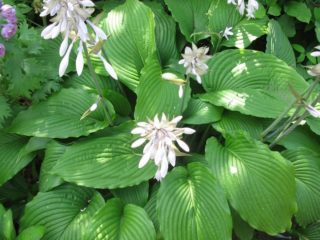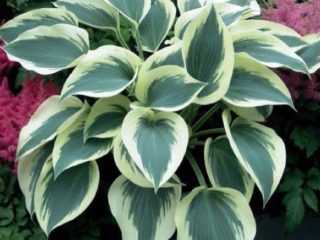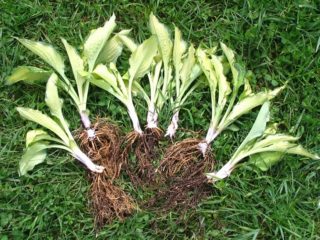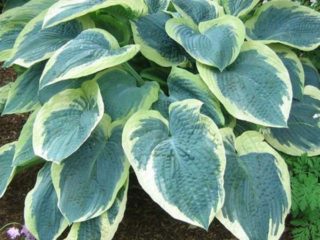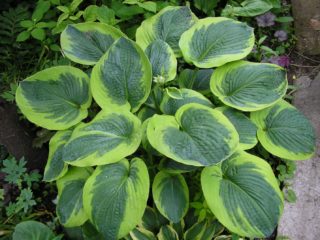Content
Hosta Autumn Frost is a perennial herbaceous hybrid. Like other varieties of this genus, Autumn Frost is actively used in gardening and landscape design. The shrub attracts with its foliage, rather unpretentious. For successful cultivation, it is important to organize certain conditions for him.
Description of Hosts Autumn Frost
Hosta Autumn Frost has the following characteristics:
- prefers partial shade, but can also grow in a sunny area;
- height 0.4 m;
- Autumn Frost bush is spreading - in diameter it can reach 0.5-0.8 m;
- the rhizome is compact or short-branched;
- heart-shaped leaves on petioles form a large basal color;
- the color of the foliage is double - the middle is gray-green, a wide border of cream or yellow;
- the shape of the leaves is varied - they can be narrow-lanceolate, broadly ovate, the edges are straight or wavy;
- possible wax bloom;
- peduncles are practically not leafy, the height can reach 1.2 m;
- the shape of the flowers is funnel-shaped or funnel-bell-shaped, the average size is 8 cm;
- inflorescence racemose, often one-sided;
- flowers are lilac, less often they are white, purple;
- Autumn Frost hosts bloom in July-August;
- no aroma;
- there are no thorns;
- self-pollinated plant;
- in one place, Autumn Frost can grow up to 20 years;
- 4-5 years pass until the full growth of the bush, the process is accelerated in a sunny place, subject to agricultural technology.
Khostu Autumn Frost can be grown in most Russian regions. In terms of frost resistance, the plant belongs to zone 4 - ideal for the Moscow region, most of Russia, the mountainous and northern regions of Scandinavia.
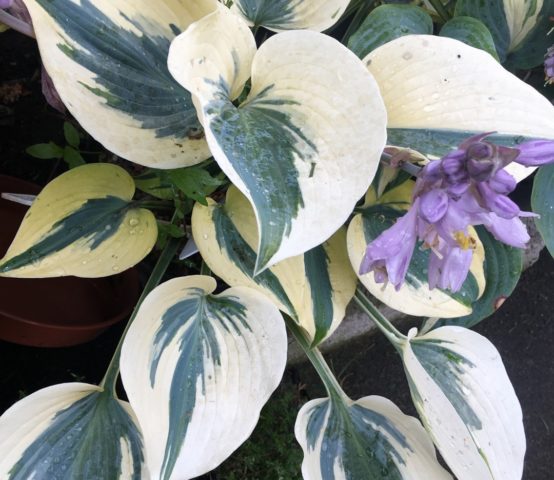
The decorativeness of the Autumn Frost hosts is provided by foliage, flowering only pleasantly sets it off
Application in landscape design
Hostu hybrid Otem Frost is grown in the open field. In landscape design, the plant is widely used. It can be used in single and group plantings - the view will always be attractive. Hosta Autumn Frost is spectacular in different compositions:
- alpine slide;
- the shore of a pond or other body of water;
- mixborder;
- rockery.
From the photo and description of the hosta Autumn Frost, it can be seen that her flowering is not lush and dim, therefore she can become an excellent background for flowering plants. If you choose a place near a reservoir, then a combination with marsh iris will be effective. In a shady place, the host looks good with morning glory of different shades, astilbe, periwinkle, marigold, liverwort, primroses. There are other options: gladioli, lavender, lilies, brightly colored lungwort, peonies, Turkish carnations, phlox.
When planting Autumn Frost, you can go in different directions of landscape design:
- create a multi-tiered composition;
- play with contrasts, planting bright flowering plants against the background of hosts;
- make an edging of the track, curb;
- fill in the empty space under trees or tall bushes.
There are many options for an artificial background for hosts. It can be a pond, masonry, stones, curbs, wood decor.
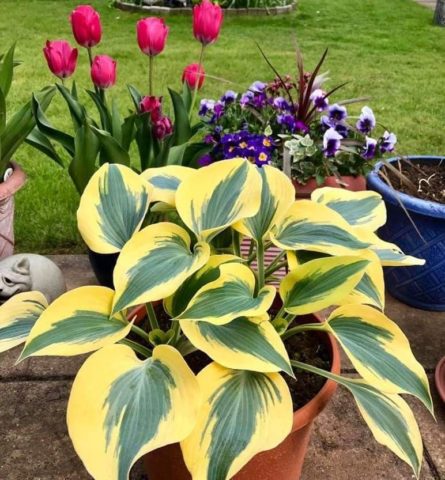
The host can be grown in large containers and pots, this option allows you to create different compositions by rearranging the plant in the right place
Hosta Autumn Frost is combined with almost all plants.Only neighbors are not recommended, from whom bulbs have to be dug out every year.
Breeding methods for hosts Autum Frost
Hosta Otem Frost can be propagated by division, cuttings, seeds. The latter method is rarely used.
It is most effective to divide an adult bush. This method has 2 main advantages - obtaining several hosta bushes at once and rapid restoration of decorativeness. They are engaged in division in early spring or in September.
Landing algorithm
Host Autumn Frost needs to be planted at a specific time:
- early autumn - you can plant the plant in late August or early September, so that it takes root before the cold weather and survives the winter;
- early spring, until the leaves have blossomed.
In growing Autumn Frost hosts, it is important to choose the right place. The plant can remain on it for many years. The main factors are as follows:
- choose partial shade or a place with diffused lighting, there should be a shadow at noon;
- the soil is slightly acidic, the acidity is almost neutral - 6.5-7.5 pH;
- the earth is moist, nutritious;
- hosta prefers light soils, the soil should be breathable;
- if the soil is too dense, peat or sand should be added;
- high humidity is desirable - the plant feels good near water bodies, reacts to this with the splendor of the bush.
For the successful cultivation of hosts, it is important to correctly select the planting material:
- roots are dense and firm, healthy white color;
- the rhizome should have 2-3 growth buds that are not overgrown;
- development and elasticity of roots, average length 11 cm, mold and rot are not allowed;
- when buying a plant in advance, before planting, store it in a dark and cool place, temperature 5-10 ° C.
It is better to choose a host with a closed root system, it is easier to plant it, and the bush takes root faster. With an open root system, there will be no flowering for the first 3 years.
The landing algorithm is as follows:
- Prepare the landing pit. The host is characterized by a strong horizontal growth of the root system, therefore a large width is important. Depth at least 0.3 m.
- Fill the hole 2/3 of the height with a mixture of compost soil, peat, rotted manure and sand. Add wood ash to the acidic earth.
- Spill the landing hole.
- Spread the roots of the plant on the ground, sprinkle. Growth buds should be flush with the surface.
- Water the planting.
- Mulch the plant, a layer of 1-2 cm is enough.
If you plant several hosta bushes at once, then you must leave at least 0.3 m between them.
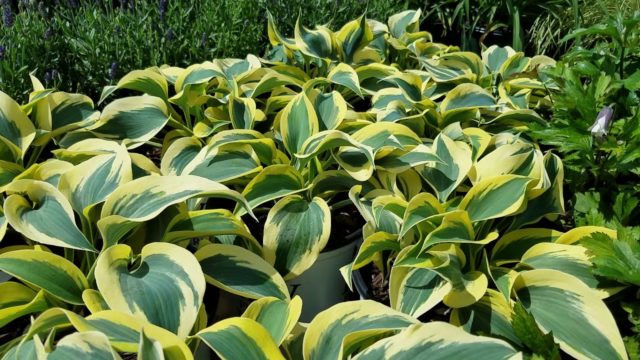
Hosta Autumn Frost can be planted in large buckets, the splendor of adult plants does not allow you to see them from above
Growing rules
The secret of successful cultivation of Autumn Frost hosts is proper planting care. It includes several stages:
- Water the hostu regularly and in a timely manner, but do not overmoisten the soil. Evening watering by sprinkling is preferred.
- Loosening should be done carefully, do not go too deep. Due to the proximity of the roots to the surface, there is a high risk of damage to them.
- Feed the host three times a season. First, spring feeding is carried out at the beginning of the growing season, then in the summer during the flowering period, and then at the end. The host needs an alternation of organic matter and mineral fertilizers. Top dressing can be both root and foliar. It is better to apply mullein infusion under the root after watering, and to embed granular minerals around the bush in the soil.
- Mulching retains moisture and nutrients in the soil, protects plantings from some pests. It is better to use compost as mulch.
Preparing for winter
Hosta Autumn Frost is characterized by high winter hardiness, therefore, it does not require special preparation for the cold. In autumn, nitrogen fertilizers cannot be used, they activate the growth of foliage, which is not needed by winter. The last feeding is carried out at the beginning of August.
On the issue of pre-winter pruning of hosts, flower growers have disagreements. The foliage of the plant is soft, therefore it successfully decomposes by spring, creating a good fertilizer. At the same time, refusal to prune is fraught with unpleasant consequences. Some pests and pathogens successfully overwinter on leaves, and cause diseases in spring and summer. Timely prevention will help to avoid the problem.
In regions with sufficient snow cover, it is not necessary to cover the host with Autumn Frost for the winter. In an area where there is little snow or frosts are too severe, this event should not be ignored.
Various mulch is used as a shelter:
- compost;
- sawdust or shavings;
- rotted manure;
- cut grass;
- straw;
- peat;
- needles.
The shelter should be organized in late autumn. A layer of mulch of 5-10 cm is enough. If the leaves are left, then they cannot be filled up. If the bush is cut off, then you can cover it with mulch.
In a region with harsh winters, nonwovens are used for shelter - agrofibre, spunbond. Airtight sheets such as polyethylene film and roofing felt are not suitable for this.
Diseases and pests
The main problem of the Autumn Frost hosts is slugs. They feed on young foliage. Because of what the plant loses its attractiveness. A good slug protection is mulch. The pest dislikes sharp materials:
- chips;
- fine crushed stone;
- crushed shell rock;
- fallen needles;
- straw.
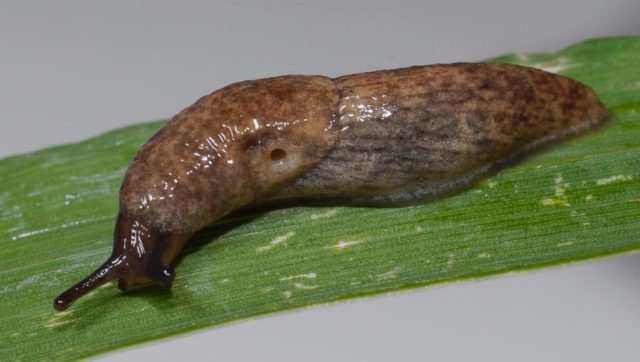
One slug over the summer is able to lay up to 500 eggs, individuals of them appear in 2-3 weeks, and after another 1.5 months they begin to reproduce
Hosta leaves are also a treat for caterpillars. You can get rid of them with the help of insecticides. The effect of spraying lasts a long time, does not harm the plants.
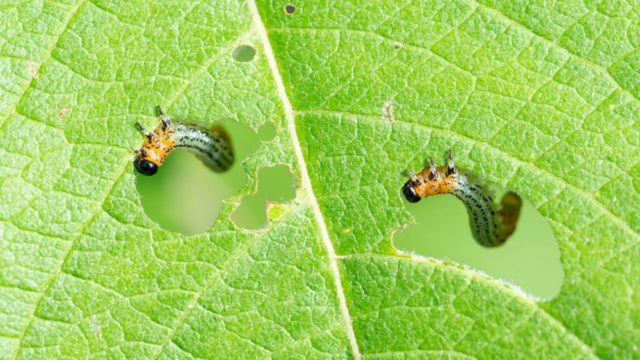
Bitoxibacillin, Lepidocide, Monsoon help well from caterpillars of different types
There is little susceptibility to diseases of the host Autumn Frost. One possible problem is phyllostictosis, also called brown spot. The disease is fungal. At the very beginning, you can cut off areas with a sharp knife, treat them with crushed activated carbon.
Plantings should be sprayed with fungicides. Instead, you can prepare a solution - add 30 g of laundry soap and 3 g of copper sulfate to 1 liter of water (dilute separately, then mix). For the prevention of the disease, Fitosporin-M is used.
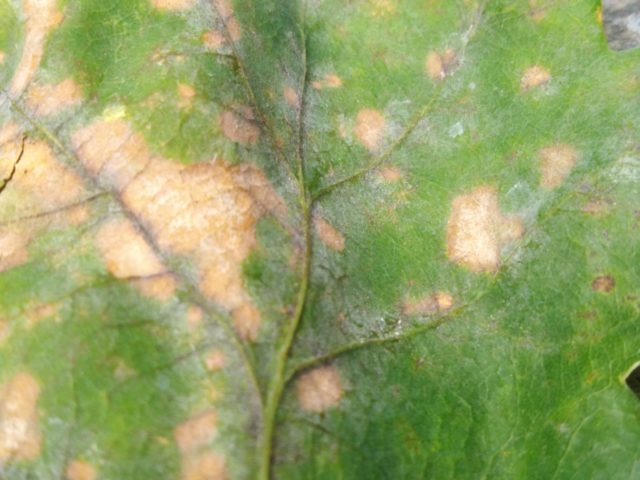
With phyllostictosis, brown spots appear on the leaves, which then cover the entire green mass
Another problem of the Autumn Frost hosts is gray rot. They also fight it with fungicides. For prophylaxis, it is necessary to burn plant residues in which the spores of the fungus persist.
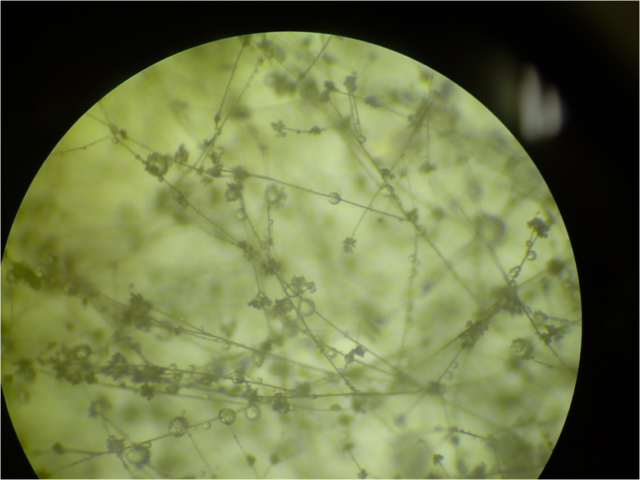
The causative agent of gray rot is the fungus Botrytis cinerea, the disease is dangerous for many plants
Conclusion
Hosta Autumn Frost is a cute ornamental plant. It is widely used in landscape design, grows in one place for many years and is unpretentious in maintenance. It is a little susceptible to diseases of the host, and slugs and caterpillars are more often affected by pests.
Testimonials
https://www.youtube.com/watch?v=G0gGWOWRxO4
